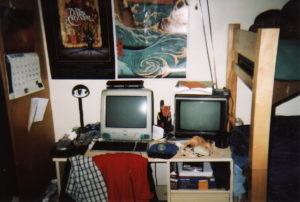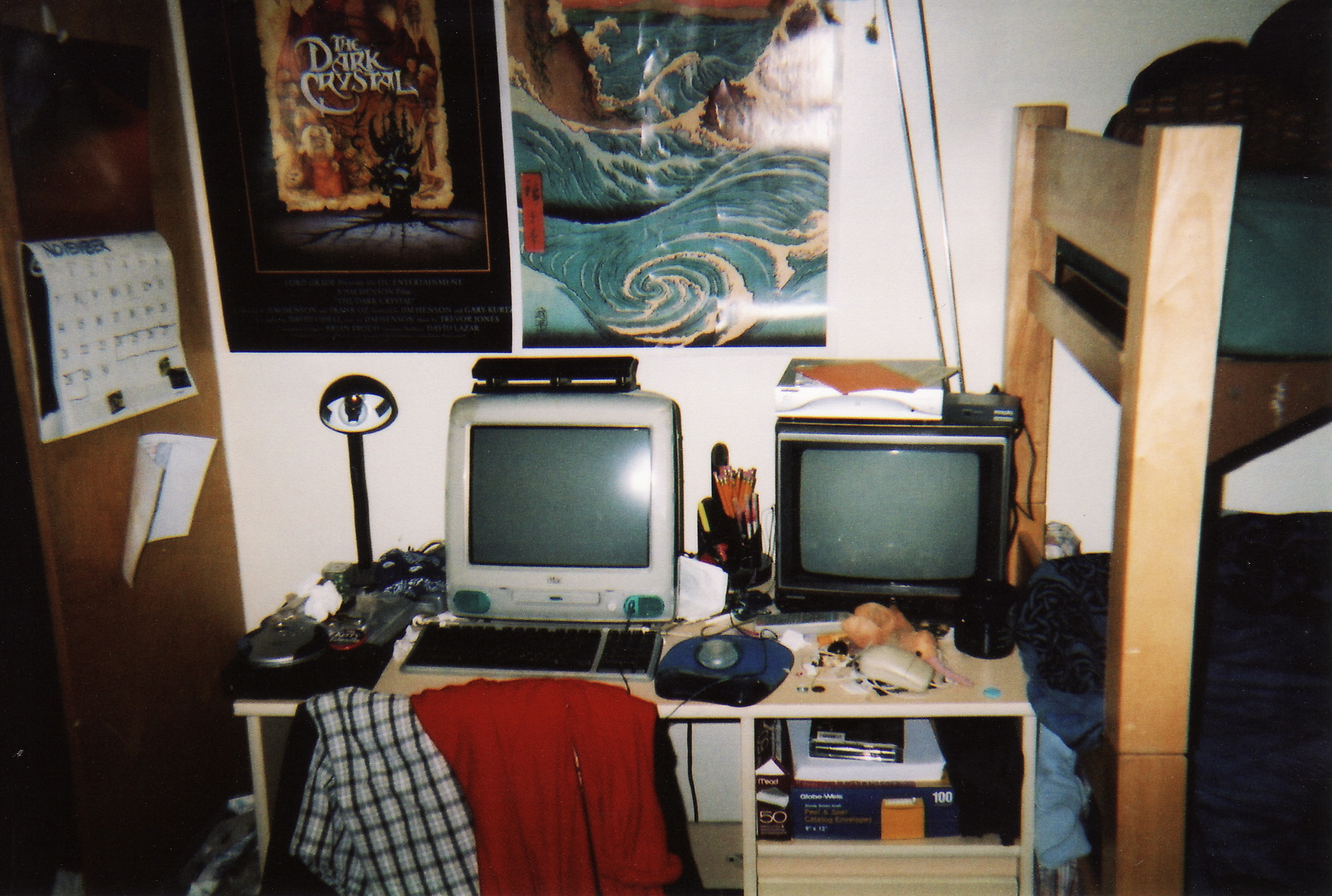
Before I was a Mac user, I was into MS-DOS. My first PC was a Tandy 1000 with a 286 CPU and less than 1MB of RAM. It didn’t even have a hard drive.
During most of the 90s, my family couldn’t afford another computer, so I had to make do with the Tandy 1000 as best I could. I wrote a novella — my first! — on it, as well as countless school papers. We had a dot-matrix printer, so printing five pages took five minutes at least, more if there were graphics. (And woe unto you if your ribbon started running dry!)
Our finances improved around the same time that the iMac — the original gumdrop shaped model — was released, and I just had to have one. My parents splurged on it, with the condition that it was a “family” computer, and I couldn’t use it all the time. (That didn’t last long, as no one else knew how to use it very well.)
Going from DOS to Mac OS 8 was like trading in a Ford Model T for a 90s-era Volvo. Things were markedly better to use than before, but when you rode in your friends’ cars, you’d be struck by how differently their dashboards were laid out, or how the steering column didn’t have the same buttons yours did. Sure, you had a modern car, but it wasn’t like the ones everyone else drove.
And God, I loved that machine.
The love affair would last 17 years, up until a trial separation led me to wonder how much I still loved the Mac.
Some of the hardware on those old iMacs was, shall we say, unreliable. That damn CD tray (this was before the slot-loading that’s commonplace now) was constantly breaking. I upgraded the hard drive, the CPU chassis, and eventually the OS before buying a Power Mac G4 on eBay.
Going from Mac OS 8 to OS X wasn’t nearly as dramatic as my migration from DOS, though there were significant trade-offs. My hardware just wasn’t good at running the OS (few Macs could), and those classic OS programs didn’t always run well (eventually they didn’t at all when Apple switched to Intel chips). But the benefits of a BSD-descended OS — namely, all those useful libraries under the hood — far outweighed those drawbacks.
OS X was the operating system on which I learned to develop for the web.
After college, my G4 was far over-extended, so I switched to a MacBook Pro with an Intel chip, then a newer model after my motherboard bit it a few years later. The unibody MacBook Pro is what I still use, with maxed out RAM and an aftermarket SSD drive. It’s the most reliable piece of hardware I’ve bought from Apple.
But when I started thinking about the laptop after, I had a lot of doubt. Apple, by then, had started soldering everything to the motherboard that it could, making their laptops impossible to upgrade. The reason I had been able to keep my current MacBook Pro was because of how easy it was to upgrade, and here was Apple trying to prevent that.
With an increased use of Microsoft products for work, I wondered if I shouldn’t make the jump to Windows.
I built my first “real” PC in 2016. I was trying to get a box capable of running VR software, though I never used it for that purpose. It wound up my media PC, running Plex to serve my copious music and video files.
After a while, I wondered if I should make it my primary device.
Here I should mention something: I had never bought an iOS device at this point. My first smartphone was a Samsung OS I’d never heard of, and my second was a Galaxy S4. It was what my coworkers recommended, and given I hadn’t bought into Apple’s cloud services by then, I felt I could make the plunge. Android, as it turns out, is pretty solid, except for how much vendors subvert the OS with bloatware and terrible UI choices. But having tried Android, and with no experience with iOS, I wasn’t enthusiastic about Apple’s direction at this point.
So I tried to make my ex-VR/media PC my primary device.
Windows … sigh. Windows never stopped sucking. They’d get things mostly okay, like with XP, then ruin the experience in the next release, like with Vista.
A PC doesn’t make for good media viewing, at least not directly. Plex is great as a web UI for media management, but it doesn’t launch programs. Kodi has program integration, but is just bonkers unstable and not much fun. Steam is good for navigating games … as long as they’re all on Steam, or you can configure it to launch external programs. And Blu-Ray support … a lowly $100 player could play discs better than the PC software I tried.
PCs do some things well, but none of those things are “general media device.”
Meanwhile, I had switched my MacBook Pro to boot to Windows directly, as I was using it solely for work at that point. I never interacted with macOS, as it is now branded, except to apply security upgrades.
Until I finally tried iOS.
IOS, as it happens, is a pretty decent games platform.
My favorite mobile game — Monument Valley — started life on that platform. Apple’s narrow hardware scope meant it could tailor iOS to work closer to the metal than Android. (That’s probably one reason why it’s pushing its proprietary 3D API, Metal.) Apple devices are more like consoles than PCs: an intuitive OS with a friendly UI, APIs that work close to the metal, and a strict approval process for new applications.
This summer, having stopped using my PC for games, I wondered if I should buy a console. I was also looking into tablets for media consumption.
So, why not an iPad? I wondered.
I bought an iPad Pro two months ago, and since then it’s become my primary device. I write emails with it, check social media on it, listen to podcasts on it, watch video on it. It’s always on, as easy to unlock as a mobile device, and apps launch quickly. It’s far fewer clicks going from lock screen to Netflix than it is on a PC.
Before, I had deep misgivings about the direction of Apple’s macOS devices, wondering if they were being subverted by iOS. The MacBook Pros got that silly Touch Bar, macOS got Siri integration, and there were rumors of ARM chips replacing Intel, as Intel had replaced Motorola in 2005.
My misgivings about Apple’s future were tied to my distrust of iOS, which I had never used. But after using it daily for weeks, I’m far more excited about Apple’s future.
Because as it turns out, iOS is (mostly) great.
(Mostly, because Apple’s “walled garden” approach to development is more like a hydroponic farm deep inside Fort Knox than a picket fence around some sunflowers. You cannot install another OS on iOS devices; you cannot sell an emulator on the App Store; you cannot sell apps that allow you to purchase or rent video; etc.)
But iOS will never have vendor bloatware, because the vendor is the OS developer, and is also the OEM. Changing settings is consistent between devices, given the same OS version. And settings make sense, without missing/hidden/broken settings due to vendor and/or telecom interference.
So yes, bring iOS apps to macOS. I tell Siri to remind me to do things all the time. Give me Monument Valley on my MacBook Pro.
Because, as it turns out, I still love using my Mac, too. I still keep Windows around, but run it in Parallels, and only when I need it for work. But it will never come between me and Apple again.
(This entire post, by the way, was written on an iPad Pro.)
